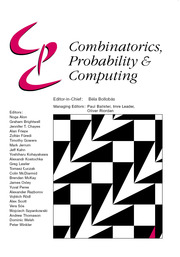No CrossRef data available.
Article contents
Noise sensitivity on affine Weyl groups
Part of:
Markov processes
Published online by Cambridge University Press: 31 July 2025
Abstract
We show that on every affine Weyl group natural random walks are noise sensitive in total variation.
MSC classification
Information
- Type
- Paper
- Information
- Copyright
- © The Author(s), 2025. Published by Cambridge University Press
References
Abramenko, P. and Brown, K. S. (2008) Buildings: Theory and Applications, Vol. 248 of Graduate Texts in Mathematics, Springer.CrossRefGoogle Scholar
Benjamini, I. F. and Brieussel, J. (2023) Noise sensitivity of random walks on groups. ALEA Lat. Am. J. Probab. Math. Stat. 20(2) 1139–1164.CrossRefGoogle Scholar
Hebisch, W. and Saloff-Coste, L. (1993) Gaussian estimates for Markov chains and random walks on groups. Ann. Probab. 21(2) 673–709.10.1214/aop/1176989263CrossRefGoogle Scholar
Kalai, G. (2018) Three puzzles on mathematics, computation, and games. InProceedings of the International Congress of Mathematicians—Rio de Janeiro, Vol. I Plenary lectures, World Sci. Publ., pp. 551–606.Google Scholar
Krámli, A. and Szász, D. (1983) Random walks with internal degrees of freedom. I. Local limit theorems. Z. Wahrscheinlichkeitstheor. Verw. Geb. 63(1) 85–95.10.1007/BF00534179CrossRefGoogle Scholar
Kotani, M. and Sunada, T. (2001) Standard realizations of crystal lattices via harmonic maps. Trans. Amer. Math. Soc. 353(1) 1–20.10.1090/S0002-9947-00-02632-5CrossRefGoogle Scholar
Kotani, M., Shirai, T. and Sunada, T. (1998) Asymptotic behavior of the transition probability of a random walk on an infinite graph. J. Funct. Anal. 159(2) 664–689.10.1006/jfan.1998.3322CrossRefGoogle Scholar
Lawler, G. F. and Limic, V. (2010) Random Walk: A Modern Introduction. Cambridge Studies in Advanced Mathematics. Cambridge University Press.10.1017/CBO9780511750854CrossRefGoogle Scholar
Pollicott, M. and Sharp, R. (1994) Rates of recurrence for
 ${f Z}^q$
and
${f Z}^q$
and
 ${f R}^q$
extensions of subshifts of finite type. J. London Math. Soc. 49(2) 401–416.10.1112/jlms/49.2.401CrossRefGoogle Scholar
${f R}^q$
extensions of subshifts of finite type. J. London Math. Soc. 49(2) 401–416.10.1112/jlms/49.2.401CrossRefGoogle Scholar
Sunada, T. (2013) Topological Crystallography: With a View Towards Discrete Geometric Analysis, Vol. 6 of Surveys and Tutorials in the Applied Mathematical Sciences, Springer.10.1007/978-4-431-54177-6CrossRefGoogle Scholar
Tanaka, R. (2024) Non-noise sensitivity for word hyperbolic groups. Ann. Fac. Sci. Toulouse Math. 33(5) 1487–1510.10.5802/afst.1803CrossRefGoogle Scholar
Woess, W. (2000) Random Walks on Infinite Graphs and Groups, Vol. 138 of Cambridge Tracts in Mathematics, Cambridge University Press.10.1017/CBO9780511470967CrossRefGoogle Scholar


